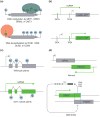Mapping the genome landscape using tiling array technology
- PMID: 17703988
- PMCID: PMC2665186
- DOI: 10.1016/j.pbi.2007.07.006
Mapping the genome landscape using tiling array technology
Abstract
With the availability of complete genome sequences for a growing number of organisms, high-throughput methods for gene annotation and analysis of genome dynamics are needed. The application of whole-genome tiling microarrays for studies of global gene expression is providing a more unbiased view of the transcriptional activity within genomes. For example, this approach has led to the identification and isolation of many novel non-protein-coding RNAs (ncRNAs), which have been suggested to comprise a major component of the transcriptome that have novel functions involved in epigenetic regulation of the genome. Additionally, tiling arrays have been recently applied to the study of histone modifications and methylation of cytosine bases (DNA methylation). Surprisingly, recent studies combining the analysis of gene expression (transcriptome) and DNA methylation (methylome) using whole-genome tiling arrays revealed that DNA methylation regulates the expression levels of many ncRNAs. Further capture and integration of additional types of genome-wide data sets will help to illuminate additional hidden features of the dynamic genomic landscape that are regulated by both genetic and epigenetic pathways in plants.
Figures

References
-
- Schena M, Shalon D, Davis RW, Brown PO. Quantitative monitoring of gene expression patterns with a complementary DNA microarray. Science. 1995;270:467–470. - PubMed
-
- Borevitz JO, Ecker JR. Plant genomics: the third wave. Annu Rev Genomics Hum Genet. 2004;5:443–477. - PubMed
-
- Mockler TC, Ecker JR. Applications of DNA tiling arrays for whole-genome analysis. Genomics. 2005;85:1–15. - PubMed
Publication types
MeSH terms
Grants and funding
LinkOut - more resources
Full Text Sources
Other Literature Sources

